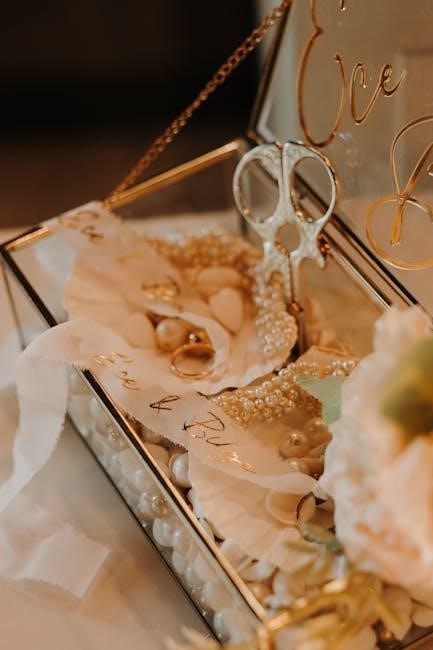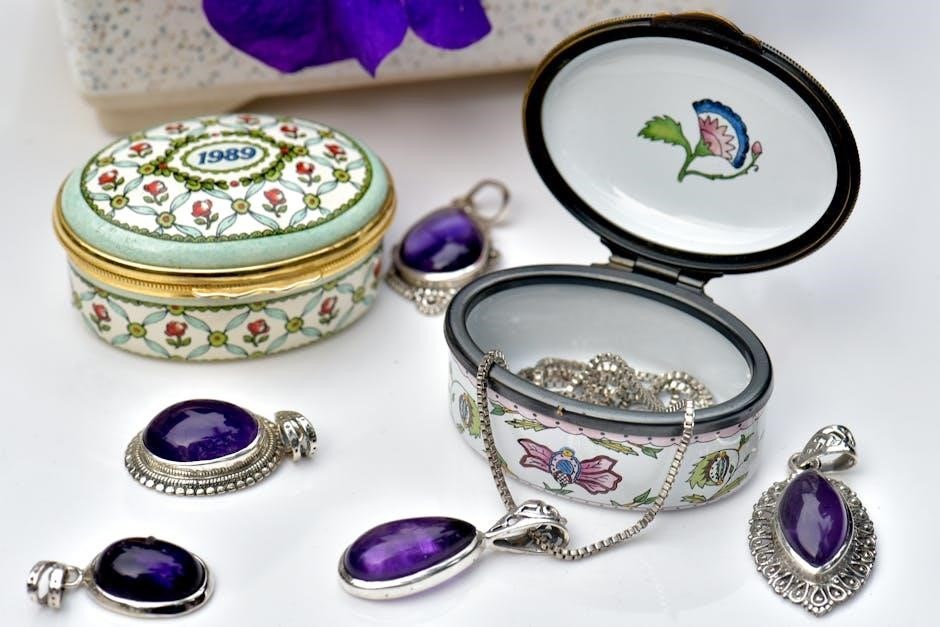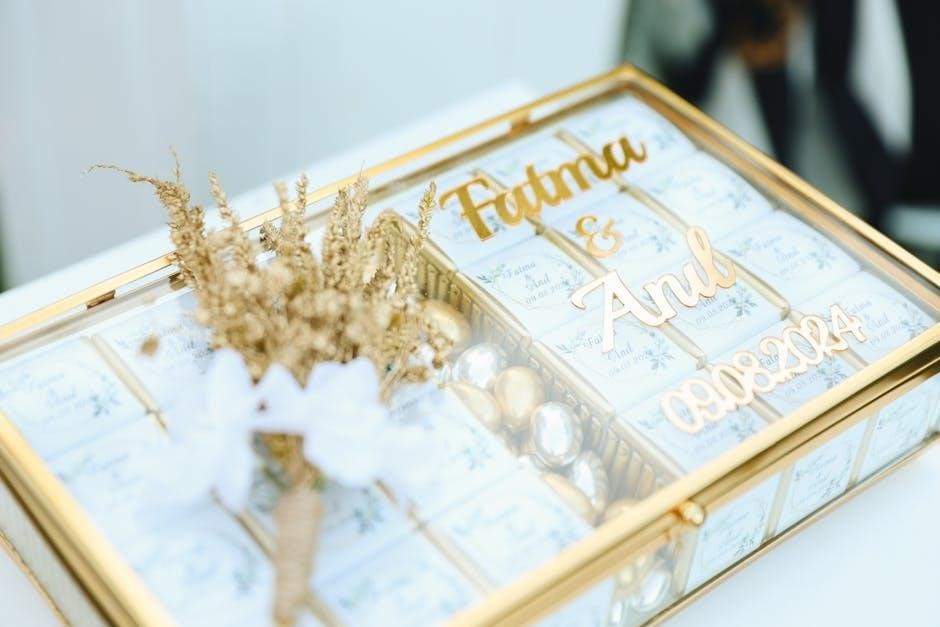A keepsake box is a heartfelt project that combines sentimental value with woodworking skills. These boxes are perfect for storing memories and make meaningful gifts.
Why Create a Keepsake Box?
A keepsake box is a meaningful way to preserve cherished memories, serving as a timeless storage for mementos. It allows personalization, making it a heartfelt gift for loved ones. Creating one fosters a sense of accomplishment and connects you to woodworking traditions. The process is therapeutic, offering a creative outlet. A keepsake box is more than just a container—it’s a treasured family heirloom that holds emotional value and tells a story.
Importance of Keepsake Boxes in Woodworking
Importance of Keepsake Boxes in Woodworking
Keepsake boxes hold significant value in woodworking as they teach fundamental techniques like measuring, cutting, and assembling. They serve as excellent projects for beginners, helping to build confidence and skill. These boxes also allow woodworkers to experiment with design elements and finishes, enhancing creativity. Additionally, they provide a practical way to practice joints and hardware installation, making them a cornerstone in woodworking education and a rewarding creative outlet.

Materials and Tools Needed
Building a keepsake box requires high-quality wood, precision tools like saws and sanders, and hardware for hinges and latches. Proper materials ensure durability and a polished finish.
Essential Woodworking Tools for Beginners
Starting with basic tools is key to successful woodworking. A table saw or handheld saw is necessary for cutting wood accurately. Sandpaper and sanders ensure smooth surfaces. Clamps help hold pieces in place while gluing. Measuring tools like tape measures and squares are crucial for precision. Safety gear, such as goggles and a dust mask, protects you while working. Chisels and hand planes add detail, while drill presses handle precise holes. These tools form the foundation for building a keepsake box effectively.
Recommended Wood Types for Keepsake Boxes
Choosing the right wood is crucial for a keepsake box. Cherry and walnut are popular for their durability and rich, dark finishes. Maple offers a lighter, versatile look and can be stained to match any décor. Mahogany is another excellent choice, combining strength with a beautiful grain pattern. For a unique aroma and natural insect resistance, cedar is ideal. These woods ensure your keepsake box is both functional and visually appealing, making it a lasting treasure.
Design Considerations
Designing a keepsake box involves balancing functionality and aesthetics. Consider size, shape, and lid style to suit the intended use and personal taste of the recipient.
Choosing the Right Size and Shape
Selecting the ideal size and shape for your keepsake box is crucial. Consider the items it will hold and the space where it will be placed. A medium-sized box, measuring approximately 11 inches long, 7 inches wide, and 6 inches high, is a popular choice, offering ample storage without being overly bulky. Opting for a rectangular shape ensures simplicity and versatility, making it suitable for various decors and uses. Additionally, a rectangular design allows for easier construction, especially for beginners, as it requires fewer complex cuts and joints. This size is also ideal for personalizing with engravings or contrasting woods, enhancing its visual appeal and sentimental value. By tailoring the dimensions to the intended purpose, you create a functional and meaningful keepsake box that resonates with its recipient.
Adding Decorative Elements to Your Box
Enhance your keepsake box with decorative elements for a personal touch. Consider contrasting woods or engravings to add visual appeal and sentimental value. A veneered lid or intricate design can elevate the box’s elegance. For inspiration, explore free PDF guides offering various styles and techniques. These resources provide step-by-step instructions to help you create a beautiful, unique keepsake box that stands out.
Construction Steps
Building a keepsake box involves cutting, assembling, and finishing wood. Follow step-by-step guides in free PDF plans to ensure precision and successful project completion.
Step-by-Step Guide to Building a Basic Keepsake Box
Start by measuring and cutting the wood according to your plan. Assemble the box using dovetail or spline joints for strength. Sand all surfaces for a smooth finish. Apply wood glue to secure the sides and bottom. Attach the lid using hinges for easy access. Add a latch or handle for functionality. Finish with paint, stain, or varnish. Allow the finish to dry before use. This guide ensures a sturdy, professional-looking keepsake box perfect for beginners.
Assembling the Box: Dovetails and Splined Miters
Dovetail joints provide exceptional strength and a classic look, while splined miters add both stability and visual appeal. Cut the dovetails using a tablesaw or miter saw, ensuring precise angles and alignment. For splined miters, add a thin spline to reinforce the corners. Sand all edges before assembly to ensure a smooth fit. Use clamps to hold the pieces in place while gluing. Allow the adhesive to set fully for a sturdy, professional finish. This method ensures durability and enhances the box’s aesthetic appeal.
Finishing Touches
Apply wood finishes like stain or polyurethane for a polished look. Sand thoroughly between coats for a smooth surface. Allow proper drying time for durability and lasting beauty.
Applying Wood Finishes for a Professional Look
Finishing your keepsake box with wood stain, polyurethane, or wax enhances its appearance and protects the wood. Sanding the surface beforehand ensures even application and a smooth finish. Stain adds color while maintaining the wood’s texture, whereas polyurethane provides a durable, glossy layer. Always follow the manufacturer’s instructions and apply thin coats, allowing each layer to dry completely before adding the next. Regular buffing can achieve a high-gloss finish, making your box look professionally crafted and lasting for years.
Adding a Hinged Lid and Hardware
Installing a hinged lid and hardware enhances both functionality and aesthetics. Small brass or silver-toned hinges are ideal for keepsake boxes, ensuring smooth opening and closing. Measure and align the hinges carefully for precise fitting. Attach the lid securely, leaving a slight gap for easy access. Adding a decorative latch or handle further personalizes the design, making the box both functional and visually appealing. Proper alignment and secure fastening ensure long-lasting durability and a professional finish.

Customization Ideas
Personalize your keepsake box with meaningful touches like engravings, contrasting woods, or unique hardware. These elements add character and make the box truly special for its owner.
Personalizing Your Keepsake Box with Engravings
Engraving adds a personal touch to keepsake boxes, making them unique and meaningful. Names, dates, or special messages can be elegantly carved into the wood. This technique enhances the emotional value of the box, turning it into a cherished gift. Many PDF plans include tips on how to achieve professional-looking engravings, even for beginners. Use contrasting wood species or aluminum accents to highlight the design for a stunning visual effect.
Using Contrasting Woods for Visual Appeal
Contrasting woods create a striking visual effect in keepsake boxes. By combining species like Birds-eye maple with bubinga or adding aluminum accents, you achieve a dynamic look. This technique not only enhances the box’s beauty but also highlights craftsmanship. Many PDF plans suggest using tapered legs or veneered lids to further emphasize the design. Such contrasting elements make the box a standout piece, perfect for showcasing personal style or commemorating special occasions.
Safety Tips
Essential safety precautions ensure a secure woodworking experience. Always wear protective gear, keep loose clothing tied back, and maintain a clean workspace to prevent accidents while crafting keepsake boxes.
Essential Safety Precautions in Woodworking
Woodworking requires attention to safety to avoid injuries. Always wear protective gear like safety glasses and gloves to shield yourself from debris and sharp tools. Ensure proper ventilation when using finishes or stains to prevent inhaling harmful fumes. Keep long hair and loose clothing tied back to avoid entanglement with machinery. Maintain a clean and well-lit workspace to reduce tripping hazards. Regularly inspect tools for damage and never use them while fatigued. Follow manufacturer guidelines for power tools and keep children and pets away from the work area. Proper safety practices ensure a enjoyable and incident-free woodworking experience.
Handling Power Tools Safely
Handling power tools safely is crucial in woodworking. Always read and follow the manufacturer’s instructions before using any tool. Ensure tools are properly grounded to prevent electric shock. Keep hands and loose clothing away from moving parts to avoid accidents. Use the correct blade or bit for the task to maintain control and prevent kickback. Regularly check tools for damage and wear, replacing worn or damaged parts promptly. Never leave running tools unattended and store them safely when not in use. Proper tool handling enhances safety and precision in your woodworking projects.

Free PDF Resources
Discover a variety of free PDF plans for keepsake boxes online, offering detailed designs and step-by-step guides for both beginners and experienced woodworkers.
Where to Find Free Keepsake Box Plans Online
Explore various online platforms offering free PDF plans for keepsake boxes, such as woodworking websites, DIY forums, and crafting communities. Websites like Woodworking Plans, MyWoodPlans, and Instructables provide downloadable guides. These resources often include detailed instructions, material lists, and diagrams. You can also find plans on platforms like PDFdrive or Issuu, which host a wide range of woodworking projects. Many creators share their designs for free, catering to both beginners and experienced craftsmen.
Downloading and Using PDF Guides Effectively
Downloading free keepsake box PDF guides is straightforward. Ensure you have a PDF reader like Adobe Acrobat installed. Organize your files in a dedicated folder for easy access. Review the plans thoroughly, checking tool lists and materials. Print the plans for workshop use, or use digital versions on a tablet. Many guides include step-by-step instructions and diagrams, making the woodworking process clearer. Look for PDFs with photos or diagrams for better visualization of the project. This approach ensures you make the most of your keepsake box plans.

Advanced Techniques
Exploring advanced woodworking techniques like splined miters, contoured sides, and veneered lids can elevate your keepsake box craftsmanship, ensuring durability and visual appeal.
Mastering Dovetail Joints for Sturdy Boxes
Dovetail joints are a cornerstone of woodworking, offering unparalleled strength and durability for keepsake boxes. These interlocking joints not only enhance structural integrity but also add a touch of elegance. Cut precisely at the table saw, they ensure a professional finish. To refine your technique, practice cutting consistent tails and pins, and consider using a jig for accuracy. Sanding the joints before assembly ensures a flawless fit, making your keepsake box truly timeless.
Creating Contoured Sides and Veneered Lids
Contoured sides and veneered lids elevate a keepsake box to a level of sophistication and craftsmanship. Achieve smooth curves using a bandsaw or sander for the sides, ensuring a seamless transition. For the lid, apply veneer using a press or iron, aligning patterns carefully for visual appeal. This technique not only enhances durability but also adds a touch of elegance, making the box a standout piece in any setting.

Budget-Friendly Options
Building a keepsake box doesn’t have to be expensive. Use affordable materials like pine or cedar, and repurpose leftover wood for a cost-effective, eco-friendly project.
Building a Keepsake Box on a Budget
Creating a keepsake box on a budget is achievable with affordable materials like pine or cedar. Repurpose leftover wood to minimize costs and add a personal touch. Use basic woodworking tools to keep expenses low. Simple designs require fewer materials, making the project cost-effective. Free PDF plans are widely available, offering step-by-step guides for beginners. This budget-friendly approach allows you to craft a meaningful keepsake without breaking the bank.
Repurposing Materials for Your Project
Repurposing materials is a creative way to build a keepsake box while reducing costs. Consider using leftover wood from previous projects or reclaimed wood from old furniture. Scrap lumber, pallet wood, or even cedar planks can be transformed into a unique keepsake box. This approach not only saves money but also adds a personal touch to your project. Get creative with materials to craft a one-of-a-kind box that holds sentimental value.
Creating a keepsake box is a meaningful project that combines woodworking skills with sentimental value. It’s a perfect way to store memories and create something special for loved ones.
Final Thoughts on Creating a Keepsake Box
Creating a keepsake box is a rewarding project that blends creativity with practicality. It allows you to craft a meaningful, personalized item that can become a cherished family heirloom or heartfelt gift. Whether for storing memories, jewelry, or small mementos, a keepsake box offers a lasting way to preserve emotions and celebrate life’s special moments. The process is both therapeutic and fulfilling, making it a project worth undertaking for woodworkers of all skill levels.
Sharing Your Finished Project
Sharing your completed keepsake box is a wonderful way to showcase your craftsmanship and thoughtfulness. Whether it’s a gift for a loved one or a personal achievement, the box holds sentimental value. Many creators share their projects online, inspiring others with their designs. Gifting a keepsake box or displaying it proudly can bring joy and satisfaction, knowing it will treasured for years to come. It’s a testament to your skills and creativity.